Can Deer Be Domesticated or Made Pets?
» Deer stories » Deer behavior » Can Deer Be Domesticated or Made Pets?As a small deer farm owners, we live amidst a collection of Fallow deer, each with its own level of tameness. While none of these animals could be deemed fully domesticated or classified as pets, they present a fascinating spectrum of behavior. It's a tale of varying temperaments, ranging from remarkably docile to freaking wild!
Why Aren't Deer Domesticated the Way Cows, Sheep and Pigs Are?
Image: BING's AI
Deer have not been domesticated to the same extent as cows, sheep, and pigs for several reasons:
- Behavioral Traits. Deer possess inherently wild behaviors that are more challenging to modify through selective breeding compared to other livestock animals. Their natural instincts, flightiness, and sensitivity to stress make them less amenable to domestication.
- Taming Difficulties. Deer can be skittish and challenging to handle, making the taming process more intricate. Unlike some other livestock species that are more naturally docile and easier to manage, deer may be more resistant to human interaction.
- Feeding and Habitat Requirements. Deer have specific dietary and habitat needs that are more challenging to replicate in captive environments. They are selective feeders, requiring varied diets based on natural vegetation that might be difficult to provide in domestic settings.
- Historical Context. Historically, humans have focused on domesticating animals that fulfill specific roles such as providing meat, milk, wool, or labor. Deer might not have been prioritized for domestication due to their behavior and the abundance of other domesticated animals that were easier to manage and offered more immediate benefits.
Overall, deer do get tamer with time, if human interaction is positive and persistent. Some animals are naturally braver and they come closer first, then they grab a treat, then take them from your hands, and then those watching in the 'second row' take note and repeat the behavior. And then one day this one doe becomes so tame she comes so close to you she steps on your foot with her hoof with nearly 100 lbs weight, and 'ouch, that hurts'! Meanwhile, some other members of the herd always keep aback, just to be on the safe side.
Still, anything out of the ordinary happens and most deer quickly flee.
- Wearing your hair in a bun today? Deer don't recognize you and get spooked, until you start talking and they hear that it is you after all.
- God forbid you wear a garment which is billowing in the wind. Terrifying for deer. They totally don't appreciate those fashion trends, you know?
- Trip on a stone while walking, nearly fall? In a split second deer who were close by can be over the hill somewhere.
- Fawn gets scared for any reason? Runs into a metal wire fence, gets stuck in it, carries on violently twitching in it. Gate is wide open 3 feet away from it. Rather run and get caught in the fence, better drama.
So that's what we're dealing here, folks.
That being said, we do have deer that are adorably trusting and impressively tame, some even appreciate a rub behind their ears. But that's after years of daily interactions and most are not as friendly.
Are Reindeer the Only Domesticated Deer Species?
Reindeer, also known as caribou in North America, are among the few deer species that have been semi-domesticated on a significant scale. They have a long history of being herded and utilized by indigenous cultures across Arctic regions.
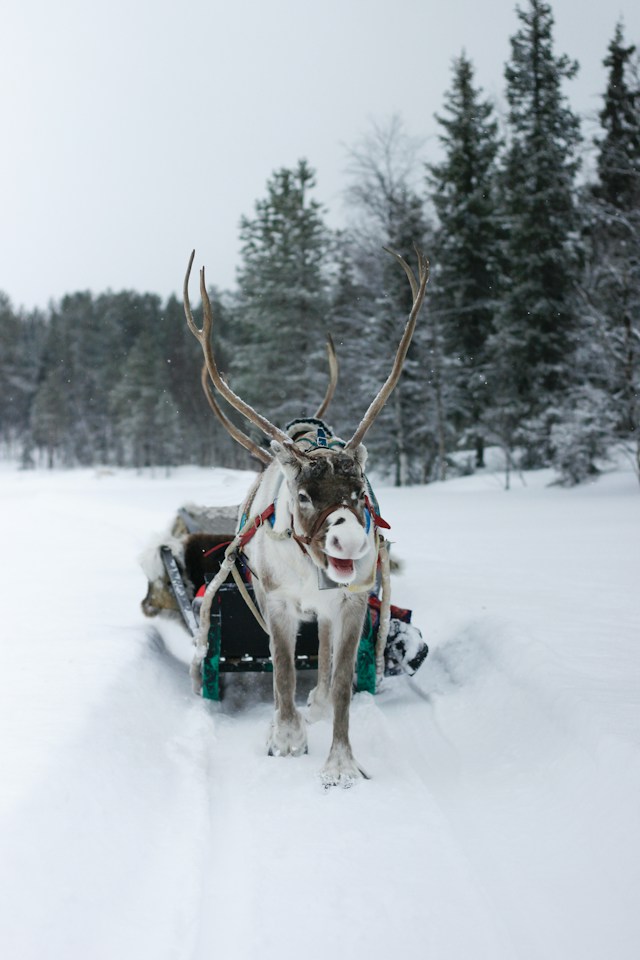
Photo by Judith Prins on Unsplash
Reindeer were first domesticated around 2,000 to 3,000 years ago by indigenous peoples living in the Arctic regions of Europe, Asia, and North America. The Saami people of Scandinavia are recognized for their extensive domestication and herding of reindeer, a practice that has been a fundamental part of their culture and survival for centuries.
These indigenous groups developed a close relationship with reindeer, using them for various purposes such as transportation, providing meat and hides for food and clothing, and utilizing antlers and bones for tools and crafts. Over time, they selectively bred reindeer to exhibit traits that suited their needs, such as docility, strength for pulling sleds, and adaptations to harsh climates.
Can You Tame a Deer?
Taming a deer is possible to some extent, but can be very challenging and carries certain risks.
Here are some considerations and steps often used in attempts to tame a deer:
- Early Exposure. Starting interactions with a deer at a young age can improve the chances of taming. Hand-rearing a fawn from an early age and providing care, including bottle-feeding and gentle handling, can help in building a bond.
- Consistent and Gentle Interaction. Regular, gentle interaction and positive reinforcement, such as offering food treats, can help develop trust. This includes spending time around the deer without causing stress or fear.
- Respect Boundaries. Understanding and respecting the deer's natural behavior and boundaries are crucial. Pushing too hard or attempting to force interactions can lead to stress and hinder progress in taming.
- Patience and Time. Taming a deer is a slow and patient process. It requires a lot of time and consistent effort to build trust and a bond with the animal. Each deer's temperament and level of tameness can vary, so progress may differ between individuals.
Even with successful taming efforts, deer retain their natural instincts, and their behavior can still be unpredictable, even when it could seem the animal has been tamed. They may startle easily, especially in unfamiliar or stressful situations, and revert to wild behavior. That is why, in many places, keeping a deer as a pet may be illegal without the proper permits or licenses due to wildlife regulations.
While partial taming or developing a level of trust with deer is feasible, achieving full domestication similar to more traditional livestock animals like cows or sheep is considerably challenging due to the innate wildness of deer species.
The Tame Deer of Japan's Nara Park
Nara Deer Park, also known as Nara Park or Nara-koen, is a famous park located in Nara, Japan. It's renowned for its population of Sika deer, considered as national treasures and designated as a natural monument in Japan.
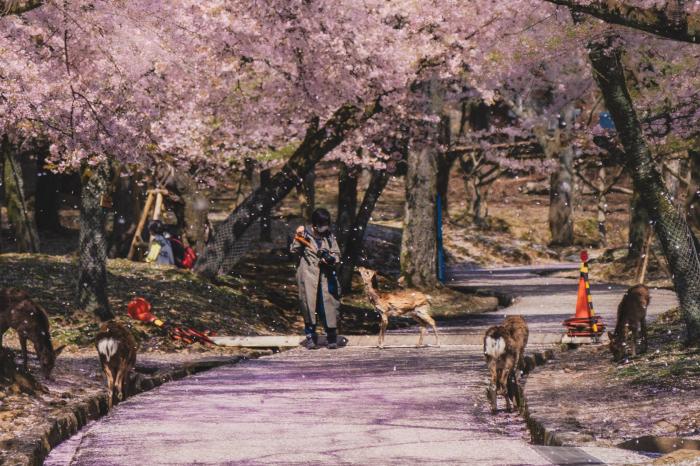
Photo by Zhaoli JIN on Unsplash
The deer in Nara Park are known for their friendliness and tameness. They have become a significant symbol of the city and are often regarded as "messengers of the gods" in Japanese culture. Visitors to Nara Park can interact with these deer, feed them specially provided shika senbei (deer crackers) that are sold in the park, and sometimes pet or take photos with them.
Nara Deer Park is an example of successful deer taming to a certain extent but not full domestication. The deer in Nara Park are accustomed to human presence and interaction due to centuries of cultural significance and being well cared for within the park. They've become accustomed to visitors and have learned to associate them with food, leading to their docile and approachable behavior.
Taming refers to altering the behavior of wild animals to make them more accustomed to human interaction, and the deer in Nara Park showcase this to a considerable degree. Visitors can approach, feed, and interact with the deer in a relatively relaxed and friendly manner.
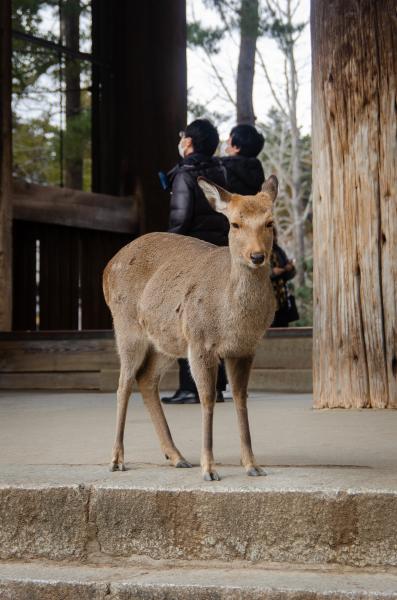
Photo by Putra Mahirudin
However, these deer are not fully domesticated. They still retain their wild instincts and are not bred for specific traits that fully domesticated animals possess. They continue to live in a semi-wild state within the park, maintaining their natural behaviors, instincts, and breeding patterns.
Therefore, while the deer in Nara Park exhibit a high level of tameness and tolerance toward human interaction, they do not represent a fully domesticated population. Instead, they highlight successful taming efforts in an environment where cultural practices and careful management have led to a peaceful coexistence between humans and these semi-wild deer.
The park's management emphasizes respect for the deer's natural behaviors while encouraging interactions between visitors and the deer. Signs and instructions are in place to guide visitors on proper interactions, feeding etiquette, and respecting the deer's space and well-being.
Can You Turn a Wild Baby Deer Into a Pet?
Hand-rearing a fawn from an early age and providing care, including bottle-feeding and gentle handling, can result in the animal becoming used to living among humans and basically seeing the feeding human as a mother figure. But while the idea of having a wild baby deer as a pet may seem appealing, it's important to prioritize the well-being of these animals.
Photo by Oleksandr P
Wild animals, including baby deer (fawns), are not suitable candidates for becoming traditional pets in the same way as dogs or cats, primarily due to:
- Legal Restrictions. In many places, it's illegal to keep wild animals, including deer, as pets without proper permits or licenses. It is illegal to own a deer in most states in the United States of America. Wildlife regulations aim to protect these animals, ensure their conservation in their natural habitats and also protect people from their wild behavior. Sometimes, people find and take care of baby deer that lost their parents. But when they do this and animal control knows, they might take away the deer and put it to sleep. If the deer can't go back to the wild and there's no suitable rehabilitator who knows how to take care of deer (because they're not common), they might have to put the deer to sleep.
- Wild Instincts. Wild animals, even when young, have innate instincts that are crucial for their survival in the wild. These instincts, such as flight responses and natural behaviors, can persist despite efforts to tame or domesticate them.
- Specialized Care. Raising a wild baby deer requires specialized knowledge and care. Their dietary needs, health requirements, and behavioral development differ from those of domesticated animals. Providing appropriate care can be challenging and requires expertise.
- Reintegration into the Wild. Attempts to keep a wild deer as a pet may negatively impact their well-being and hinder their ability to survive in the wild if they are released later. Remember that bucks become very aggressive when they mature and it's mating season. There have been cases of pet bucks killing their owners. Our advice is never attempt to make a pet out of a male deer. Even if they see you as their mother, when they grow up they don't treat their moms with a lot of respect. They may come up and kick her, boss her around. Does (females) can be naughty too, but they're never as aggressive.
On our farm, we've had a few fawns being born in front of our eyes, who have seen and heard us from day 1 for several days, saw us approaching their mothers, mothers trusting and coming closer. But fawns still had their guards up. It seems to be hard-wired. Even if the baby deer is following its mother who is coming our direction, it will try to hide behind her, standing as far as possible. Baby deer are extremely fearful and skittish. It is actually easier to 'befriend' a year old than a 3 days old deer, unless you flat out rear the fawn yourself (then it's going to be thinking you're mother and trust you). But rearing a fawn is not easy, feeding every 4 hours.
One famous actress known for having a pet fawn was Audrey Hepburn. She famously had a pet deer named Pippin, whom she raised and cared for during the filming of the movie "Green Mansions" in 1959. The story goes that Audrey found the abandoned fawn on set and took it under her wing, nurturing and raising it.
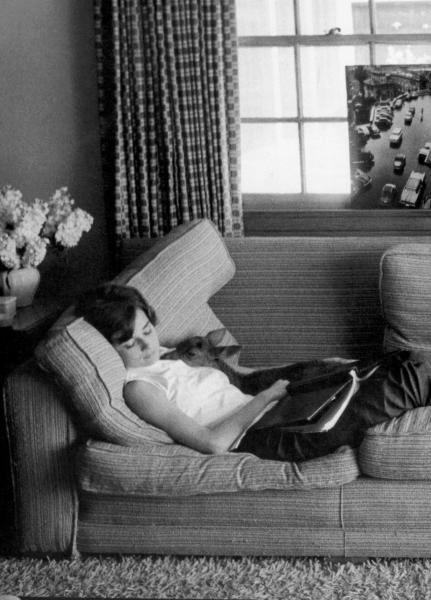
Audrey Hepburn and Ip photographed by Bob Willoughby, 1958
Pippin became a beloved companion to Audrey Hepburn during the filming period. Hepburn was known for her love of animals and her compassionate nature, and her bond with Pippin showcased her deep affection for animals.
The story of Pippin, Audrey Hepburn's pet fawn, took a bittersweet turn. As Pippin grew, it became increasingly challenging to keep a wild animal as a pet. Eventually, Hepburn made the difficult decision to find a suitable home for Pippin where it could live in a more natural environment.
Hepburn arranged for Pippin to be placed in a deer sanctuary, where the fawn could live among other deer in a setting closer to its natural habitat. Although it was undoubtedly a heartfelt and difficult decision for Hepburn, she ensured Pippin was placed in a safe environment where it could live out its life more in tune with its instincts and surrounded by other deer.
While the specifics of Pippin's later life aren't widely documented, it's understood that Audrey Hepburn remained deeply attached to the memory of her beloved pet fawn, showcasing her love and care for animals even after their time together ended.
Still, there are reports of pet deer living their best lives. If one day we have to rescue one of our fawns and raise it ourselves, we might have more first hand experience to share with you. :) Meanwhile ...
Here in rural New Zealand, people own all kinds of pets: horses, goats, llamas and deer! We don't personally know pet deer owners, but seen people bring their alpacas to local shows. You can read some personal stories from people who've had pet deer on this forum.
Are you still determined to get a pet deer? Tell us in the comments!
Last modified 15 April 2025 at 18:17
Published 27 December 2023
Add your comment
 '
'
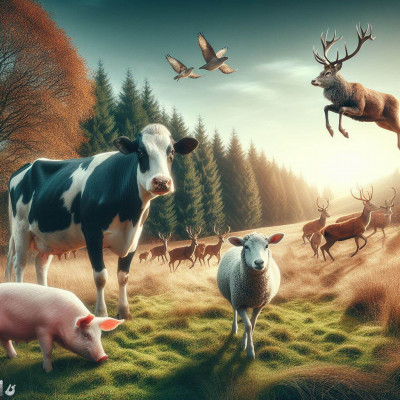
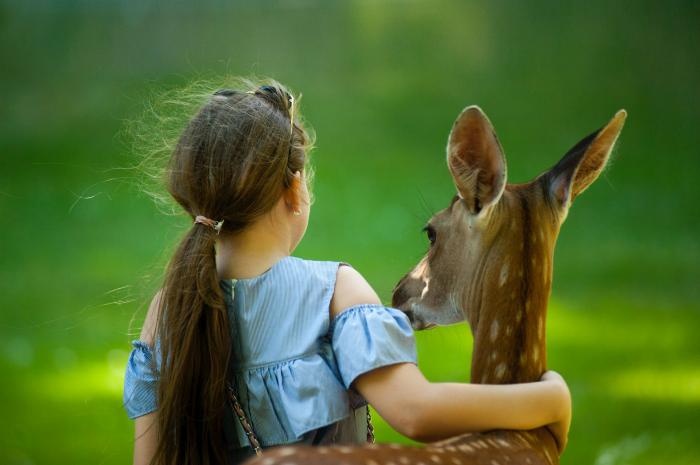
Robbo 15-01-2025:
Quite a few years ago I obtained a newborn doe fallow deer fawn from a veterinay surgeon who also farmed deer for food. I named the fawn Holly, a name suggested by the vet's children when I collected my new pet, as it was almost Christmas.
Holly, who is still with me and treats me as a close friend, lives on my rural hobby farm with my dogs, cats, sheep - and now with two other fallow deer does surrended to me when their previous owner moved into suburbia. Before the other deer came to stay, Holly sometimes went wandering, jumping a fence to go inro nearby bushland. Since the other deer arrived she no longer showed any interest in leaving my property - a welcome change because I have a neighbor who loves to shoot anything that moves (I think he would like to shoot me, as we have had a few run-ins over livestock wandering through a poorly maintained boundary fence, the maintenance cost to which he doesn't believe he should contribute.
Holly and the other deer love dog biscuits as treats and idolise my German Shepherd and Italian Maremma livestock guardian dogs.